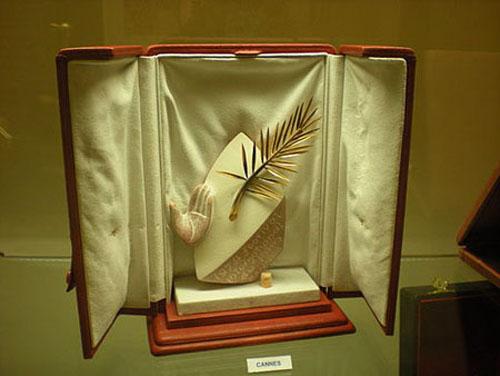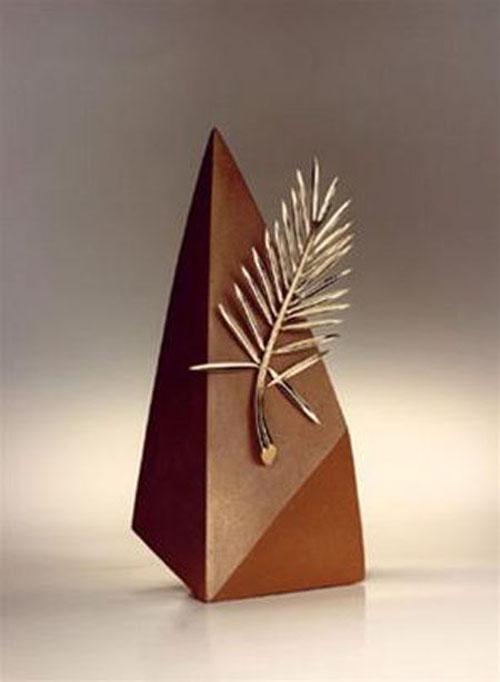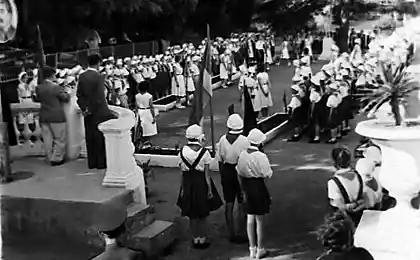1209
Palme d'Or.
Tonight will be announced the names of the holders of the Palme d'Or - the top prize at the Cannes Film Festival. In the meantime, members of the jury vote and decide who to award the honorary award, I bring to your attention a brief history of the Palme d'Or, which has nearly 60 years.

Until 1954, the main prize of the festival was not familiar to us Palme, and the award named "Grand Prix". It is the product of a fashionable painter or sculptor of the time, and every year look different (ie, every year the prize was chosen to create a new figure of art). By the end of the year, at the initiative of Robert Favre Le Bret, who served as chairman of the festival, it was decided to establish a special prize, which reflects the essence of the festival. As a symbol has been selected Palm depicted on the emblem of Cannes. Design palm branch was designed by French jeweler Lucien Lazonom. Golden branch was attached to a clay pedestal with the image of an open palm and a small recess in the shape of a heart. In 1955, the first in the history of the Festival was awarded the Palme d'Or director Delbert Mann for his film "Marty».

Until 1964 Palm in its original design was the main festival award, but after problems with the copyright for the prize, she was again replaced by a "Grand Prix", which were presented in Cannes until 1974. The following year, Palm finds a second life and becomes the main prize and the symbol of the festival. This time the award is "packed" in a heavy case of red morocco c upholstery white suede.

By the early 80th round pedestal which holds a palm branch, turns into a stone pyramid, and in 1992 the designer Thierry de Burkenya transforms it into a transparent crystal is hand-cut.


In the late 90's Palme became what we know it now. Today, the production of the Cannes prize engaged a Swiss jewelry house Chopard and to him we owe the original design awards. It all began in 1997, when on the Croisette, near the Palais des Festivals, where the annual film festival, has opened a new boutique Chopard. It was then the president of the festival Pierre Viot meets Caroline Scheufele, artistic director of the jewelry brand, and invites her to improve the appearance of the awards. Madame Scheufele enthusiastically takes on the case and after some time on the court Viot provides a sketch of the "new" Palm.

Olive Branch Chopard poured from 24-carat gold and rests on a rigid crystal emerald-cut crystal. Stem branch ends heart - a symbol of the jewelry house. The award is stored in case of blue morocco leather with suede interior trim.




Each award is made by hand a few months before the festival and is a unique piece of jewelry. Since 2000, the tradition of handing palm touched and actors - are now the best performers of female and male roles receive as a prize a small copy of the Palme d'Or.

In the history of the festival no director could not win the grand prize Cannes three times. Two-time winner Golden Palm, among others, are Emir Kusturica, Francis Ford Coppola and Michael Haneke. Woman won the main prize only once - it was the New Zealander Jane Campion, which received the Palme d'Or in 1993 for the film "The Piano."

Until 1954, the main prize of the festival was not familiar to us Palme, and the award named "Grand Prix". It is the product of a fashionable painter or sculptor of the time, and every year look different (ie, every year the prize was chosen to create a new figure of art). By the end of the year, at the initiative of Robert Favre Le Bret, who served as chairman of the festival, it was decided to establish a special prize, which reflects the essence of the festival. As a symbol has been selected Palm depicted on the emblem of Cannes. Design palm branch was designed by French jeweler Lucien Lazonom. Golden branch was attached to a clay pedestal with the image of an open palm and a small recess in the shape of a heart. In 1955, the first in the history of the Festival was awarded the Palme d'Or director Delbert Mann for his film "Marty».

Until 1964 Palm in its original design was the main festival award, but after problems with the copyright for the prize, she was again replaced by a "Grand Prix", which were presented in Cannes until 1974. The following year, Palm finds a second life and becomes the main prize and the symbol of the festival. This time the award is "packed" in a heavy case of red morocco c upholstery white suede.

By the early 80th round pedestal which holds a palm branch, turns into a stone pyramid, and in 1992 the designer Thierry de Burkenya transforms it into a transparent crystal is hand-cut.


In the late 90's Palme became what we know it now. Today, the production of the Cannes prize engaged a Swiss jewelry house Chopard and to him we owe the original design awards. It all began in 1997, when on the Croisette, near the Palais des Festivals, where the annual film festival, has opened a new boutique Chopard. It was then the president of the festival Pierre Viot meets Caroline Scheufele, artistic director of the jewelry brand, and invites her to improve the appearance of the awards. Madame Scheufele enthusiastically takes on the case and after some time on the court Viot provides a sketch of the "new" Palm.

Olive Branch Chopard poured from 24-carat gold and rests on a rigid crystal emerald-cut crystal. Stem branch ends heart - a symbol of the jewelry house. The award is stored in case of blue morocco leather with suede interior trim.




Each award is made by hand a few months before the festival and is a unique piece of jewelry. Since 2000, the tradition of handing palm touched and actors - are now the best performers of female and male roles receive as a prize a small copy of the Palme d'Or.

In the history of the festival no director could not win the grand prize Cannes three times. Two-time winner Golden Palm, among others, are Emir Kusturica, Francis Ford Coppola and Michael Haneke. Woman won the main prize only once - it was the New Zealander Jane Campion, which received the Palme d'Or in 1993 for the film "The Piano."























